Red Light, Blue Light
Along with other developments such as radium and X-rays, the use of light to treat disease was studied extensively by nineteenth-century medical science. Unlike X-rays and radium, which were more recent discoveries, the use of light to treat disease extends back into prehistory and, because of this, was sometimes associated with mystical or religious ideas that stretched the bounds of credibility.
Early therapeutic uses of light were generally restricted to sunlight. However, the introduction of electric lighting and the development of powerful light sources enabled light cures to move from outdoors (heliotherapy) to indoors (phototherapy) and for treatments that used controlled coloured light (chromotherapy). There was some scientific research done in all these areas throughout the nineteenth century but it was the pioneering work of Neils Finsen [1860-1904] in the 1890s that brought the use of light therapies to the attention of the medical profession and gave it an acceptable standing.
Finsen light treatments
After investigating the benefits of phototherapy in the treatment of several diseases, including tuberculosis and smallpox, Finsen designed a carbon arc lamp to treat patients with the skin disease, lupus vulgaris. After his initial successes he founded the Finsen Institute for Phototherapy in Copenhagen in 1896. Finsen received a good deal of support from Queen Alexandra of Great Britain and, as a result, a Finsen Institute was opened in London in 1901, followed by other Light Treatment Centres in major cities across the western world (Russell & Russel, 1933). In 1903, Finsen was awarded the Nobel Prize in Medicine “for treatment of diseases, especially lupus vulgaris, with concentrated light radiation” which put a seal of approval on many of his ideas.
Finsen’s work with light was widely reported in scientific literature and the popular press and this helped stimulate research into the physiological effects of light, including the effects of exposure to different colours. Some of these discoveries, and their practical applications, were picked up by Beauty Culture but it is only those concerning coloured lights that I will discuss here.
Coloured light
In the early part of the twentieth century light was viewed as having a ‘threefold character’ as consisting of: thermic/heat rays, which included orange, red and infra-red light; luminous/light rays, which emanated from green or yellow light; and actinic/chemical rays, made up of blue, purple, and ultra-violet light. The thermic and actinic ends of the spectrum were of particular interest to medicine and each had their medical uses. Blue light was claimed to have sedative and disinfectant effects, whereas red light was regarded as warming and stimulating.
From numerous investigations it is now believed that the violet and ultra-violet are bactericidal and antiseptic; the blue rays and the central portion of the spectrum are tonic, sedative, and penetrative; the red and infra-red are stimulative, slightly irritant, deeply penetrative, and thermal.
(Dugan, 1910, p. 189)
Like so many other things that began in medicine, the use of red and blue light was picked up by Beauty Culture and incorporated into its routines. The rationale for their use in salons broadly followed the medical thinking of the time although, on occasion, it included some psychological/perceptive effects of colour as well.
Pure white light arc lamp produces a chemical effect, has an antiseptic action and will, in many instances, blister the skin.
The ultra violet light (only found in very expensive apparatus, and never even exhibited to the average shop owner) is antiseptic and chemical in action, having marked germicidal powers. It is used for the treatment of lupus, and various other obstinate skin growths.
The blue light is antiseptic, tonic, penetrative, and acts as a germicide, having a mildly irritating effect on the skin though at the same time it seems to produce a sedative effect on the nerves.
The red light is so deficient in chemical rays that it is hardly more marked than darkness, but it produces more heat-rays than other lights, is more stimulating and penetrating.
The yellow light produces a less marked effect than the red light.
The green light is more marked than the yellow and differs materially from the blue.
The ordinary white light produces an effect much like the sunlight but is not so strongly germicidal as the blue light, and when used on the bare skin is apt to produce some discoloration, if used for any length of time.
For this reason after considering all of these lights it will be seen that the two lights to be used with the greatest benefit will be the red and blue lights.(Lloyd, 1923, pp. 188-189)
Blue Light has an antiseptic, tonic and irritating effect on bare skin. It is deficient in heat rays, has a sedative effect on the nerves, used in all cases of germ conditions on the face and scalp. Its rays have more than just a superficial effect on the part of the body where used.
… The Red Light has very little, if any chemical rays, same being filtered out, but has very strong heat rays, stimulating and tonic effect when used over the bare skin, and penetrates more deeply than the blue light.(Blood, 1927, pp. 330-331)
Coloured light treatments in beauty culture
Some red and blue glass globes were used in beauty salons but most of the blue and red light treatments conducted in Beauty Culture used white lights with red or blue glass screens placed in front of them. The globes varied in strength depending on the salon practice but were probably no higher than 100 watts. Even so, they could get quite hot an needed to be handled with care. As with all light sources the inverse square law applies, which means that reducing the distance between the client and the light source by half increases the light intensity by a factor of four. Positioning the light a set distance from the client was therefore very important. This would be the case even with a blue light – that was supposedly devoid of thermic rays – as a 100 Watt light gets very hot.
If the eyes needed protecting during the treatment, clients would be asked to keep them closed or they would be covered with cotton wool or gauze saturated in water or witch hazel.
Coloured light was used in facial and scalp treatments, either as a step in the treatment, e.g. during a facial massage, or in conjunction with a lotion, cream or mask. Blue light was not considered to be deeply penetrating so was used on completely bare skin from which all traces of powder, cream or lotion had been removed. This would also expose any bacteria on the skin to its supposed germicidal effects.
Blue light
This light was said to have an antiseptic and astringent action and was considered soothing to the nerves but irritating to the skin. It was recommended for acne, psoriasis, eczema, and similar skin conditions.
This light is antiseptic, has a somewhat irritating effect on the skin and is excellent for use in all germ troubles or in such conditions as Acne, Eczema, Psoriasis and similar troubles of the face and scalp.
In Acne, it is often beneficial to expose to patron to the light for some time before beginning the treatment. This is not only because of the effect on the skin but also because this light is peculiarly soothing to the nerves and those exposed to its rays become more relaxed and the treatment is more efficacious.(Lloyd, 1923, pp. 190-191)
Acne Treatment
1. Cleanse with cleansing cream if skin is dry, medicated soap if skin is oily.
2. Employ Vapor and Steam Generator.
3. Remove comedones, open pustules.
4. Sponge with Antiseptic Lotion.
5. Blue light over bare skin; 5-10-15 minutes as needed.
6. Apply Acne Cream.
7. Employ Facial High Frequency electrode 10-20 minutes.
8. Give manipulations on back of neck and shoulders only.
9. Remove cream.
10. Sponge with antiseptic lotion.
11. Apply Acne lotion, Positive Galvanism or use Multiple Facial Electrode.
12. Make-up. Medicated Powder. No rouge.(Blood, 1927, p. 140)
Red light
This light was considered to be stimulating to the nerves but soothing to the skin. It was recommended for dry, rough or wrinkled skin and, being a mild heat source, was used to increase the absorption of skin creams or help dry out a facial mask. However, if a heat source was needed, an infrared lamp would be more effective.
The red light has nearly all of the chemical rays excluded and therefore, although it has a tonic effect on the skin, it is less an irritant than the blue light.
It is excellent for use on dry, shriveled, wrinkled, scaly or rough surfaces, including face, neck, hands and arms.
For faces covered with tiny lines, necks that are obstinately wrinkled and hands that are rough and unpresentable nothing is better. It is also good for sensitive skins with blackheads.(Lloyd, 1923, p. 190)
Dry Skin Treatment
1. Cleanse with cleansing cream.
2. Red Light over bare skin.
3. Pat in Muscle Oil.
4. Apply Tissue Builder and Bleaching Cream.
5. Red Light over cream.
6. Manipulations.
7. High Frequency electrode, 10 to 15 minutes.
8. Remove cream.
9. Sponge Finishing Lotion.
10. Multiple Facial Electrode on the face.
11. A little Tissue Builder Cream for foundation.
12. Make-up.(Blood, 1927, p. 136)
It is difficult to know how widespread the use of red and blue lights was in early Beauty Culture. Firms that sold electrical equipment promoted them but, as they were an optional part of beauty treatments, therapists could function perfectly well without them. However, references were still being made to their use in salons up to the outbreak of the Second World War.
Some points you should know about light.
Used as white light there is a distinct bacterial action and treatment is particularly effective on the nerve centres. This gives the infra-red or heat ray. It is used largely for the relief of pain or irritation, especially on the nerve centres.
The same bulb, used with a red screen in front of the lamp, gives a warm, penetrating heat, although it is not likely to destroy bacteria to the same extent as the white light. The effect of using the red screen is to cut out all the other colours of the spectrum, leaving red only, and the colour has an effect on the client, who will react favourably to warmth.
Used in conjunction with creams or oils, which depend for their effect upon penetration, this is very valuable. It increases penetration and enables the skin to absorb such oils rapidly. The same lamp is used immediately prior to and after exposure to ultra-violet light ray.
By using the blue screen in front of the light bulb it is possible to cut out all colours other than blue. Its effect is both tonic and antiseptic. When treating cases of acne this will be found of great benefit.
I think it is correct to say that the use of the blue light will grow considerably during the next year or two. At present it has not reached its full period of usefulness. Outside beauty culture it is not used very extensively but I should certainly advise every beautifier to become acquainted with it and its effects. The ray is cold but the effect is soothing. As it does not penetrate to such a degree as either of the other types exposures may be longer.
The blue light is not used in conjunction with creams or oils; in fact their presence would be detrimental to the beneficial effects.
All treatments of this kind are given on bare skin, and the lamp should be at a distance sufficient to prevent discomfort or burning. It is best to commence with short exposures, gradually lengthening the time as it is found how the client reacts to the treatment.
Pigmentation forms a valuable guide to deciding the initial exposure. Those with dark skin can stand a longer exposure than fair skinned people.
With white, red, or blue light the eyes are protected with pads of cotton wool saturated with witch hazel. When the ultra-violet rays are in use the eyes of the operator and client must be protected with goggles of dark glasses.
Infra-red rays are invisible long rays and ultra-violet are invisible short rays, but the latter are quite distinct in appearance and effect from the violet ray treatment given by means of a generator and glass electrode.(The Hairdresser and Beauty Trade, 1936, p. 7)
Home treatments
Products were also made for use in the home both before and after the Second World War. The first that I know of was a small, hand-held device used by Helene Pessl in Vienna that went under the name Floros.
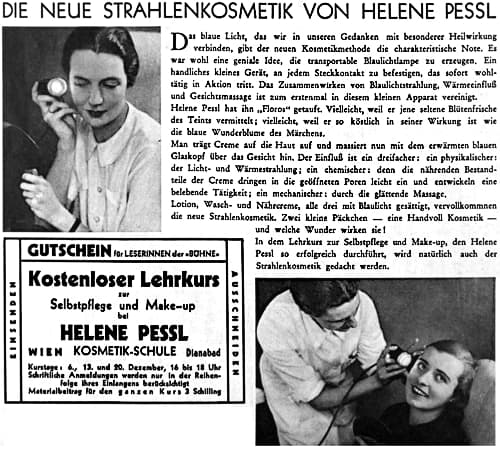
Above: 1935 Helene Pessl Floros (Vienna).
Google translates the text as follows:
THE NEW RADIATION COSMETICS BY HELENE PESSL
The blue light, which we associate with a special healing effect in our thoughts, gives the new cosmetic method its characteristic note. It was probably a brilliant idea to create the portable blue light lamp. A handy little device that can be attached to any plug contact and immediately goes into charitable action. The interaction of blue light radiation, the influence of heat and facial massage is combined for the first time in this small device. Helene Pessl christened him “Floros”. Perhaps because it conveys that rare floral freshness of the complexion; perhaps because it is as delicious in its effect as the blue wonder flower of the fairy tale. Cream is applied to the skin and then massaged over the face with the warmed blue glass head. The influence is threefold: a physical one: light and heat radiation; a chemical one: because the nourishing components of the cream easily penetrate the opened pores and develop an invigorating activity; a mechanical one: through the smoothing massage. Lotion, washing and nourishing cream, all three saturated with blue light, complete the new radiant cosmetics. Two small packages – a handful of cosmetics – and what wonders they work! In the course on self-care and make-up that Helene Pessl is so successful in, radiation cosmetics will of course also be considered.(Helene Pessl advertisement, 1935)
Also see: Helene Pessl
Given that the devices were used to massage the skin when warmed, they can also be thought of as a type of facial iron – one that combined heat and massage with light. Like facial irons they were also said, by some, to remove wrinkles.
See also: Facial Irons
The original device was meant to be used with a hormone cream. However, one British company combined it with a special radium cream instead.
From Vienna comes a new massage beauty treatment for the home. It is a special blue-rayed lamp for massaging the face, toning up an revitalising the skin. The bue rays help to refine the pores, smooth out lines, and clear blemishes.
To use this lamp you just spread a special radium cream on your skin, massage the face, neck and arms all over with the little lamp for about ten minutes. The cream and blue rays together do the work.(Floros advertorial, 1939)
Claims were not limited to skin treatments. For example, the Dermina Blue Light Treatment Lamp claimed that the device also had a soothing effect on headaches as well as neuralgia and rheumatic pain.
See also: Floros Bluelight Radiation Apparatus (c.1959)
High Frequency
A brief mention should be made of high frequency treatments. The glass bulbs of ‘violet ray’ devices used in these treatments also produced light of different colours – from red to purple to white – depending on the composition of the gas contained in the glass electrodes. It is not surprising then that some of the supposed beneficial effects of these treatments were similar to those ascribed to red or blue light.
See also: High Frequency
Decline and resurgence
In the post-war period the medical profession moved away from many previously used practices including light therapies, with the use of coloured lights being abandoned after it was realised that their effects were largely psychological. Practices tend to persist in Beauty Culture long after they have been discarded by the medical profession so red and blue light treatments may have been used in some salons after 1950. However, in their current format their time was largely done. The same cannot be said of infra-red and ultraviolet light treatments.
Both red and blue light treatments have undergone a resurgence in recent times through the use of light-emitting diodes (LEDs). Unlike the red and blue lights of the past, LED lights are cool and can be manufactured to produce either red or blue light in a narrow spectrum. Red LED light beauty treatments are said to reduce the appearance of fine lines and wrinkles, improve uneven skin tone, reduce the size of skin pores and generally brighten and rejuvenate the skin. Blue LED light is said to be able to kill Propionibacterium acnes bacteria and it is used in beauty treatments said to improve skin blemishes including acne. Both claims are similar those made in the 1920s and 1930s.
First Posted: 14th March 2012
Last Update: 30th August 2021
Sources
Banford Academy of Hair and Beauty Culture. (1938). Theory and practice of scientific facial culture and muscle strapping. A textbook for the profession (Vol. 2). New York: Beauty Laboratories, Inc.
Beauty Culture. (1936). The Hairdresser and Beauty Trade. 4(19), 7. London.
Blood, I. H. (1927) The cosmetiste: A handbook on cosmetology with special reference to the employment of electricity in the care of the hair, scalp, and face at the direction and under the supervision of W. M. Meyer (4th ed.). Chicago, Ill: The W. M. Meyer Co.
Busck, G. (1903). The Finsen light treatment. The American Journal of Nursing. 3(10) 753-755.
Dugan, W. J. (1910) Handbook of electro-therapeutics. Philadelphia: F. A. Davis company.
Lloyd, E. (1923). The Marinello text book (5th ed.). Chicago: Marinello Company.
Matijaca, A. (1917). Principles of electro-medicine electro-surgery and radiology. A practical treatise for students and practitioners. Bulter, NJ: Benedict Lust.
Russell, E. H., & Russell, W. K. (1933). Ultra-violet radiation and actinotherapy (3rd ed.). Edinburgh: Riverside Press.
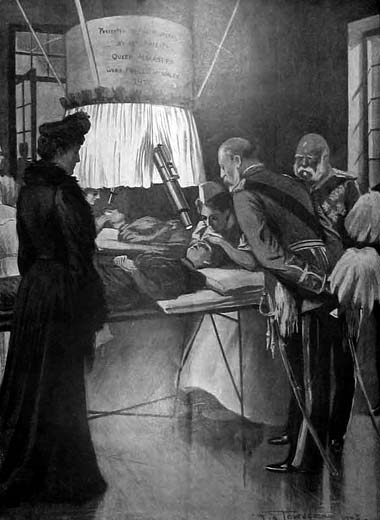
1903 The Finsen Institute in London being visited by Edward VII and Queen Alexandra.

Diagram of a medical apparatus for a treatment using incandescent light (Dugan, 1910).
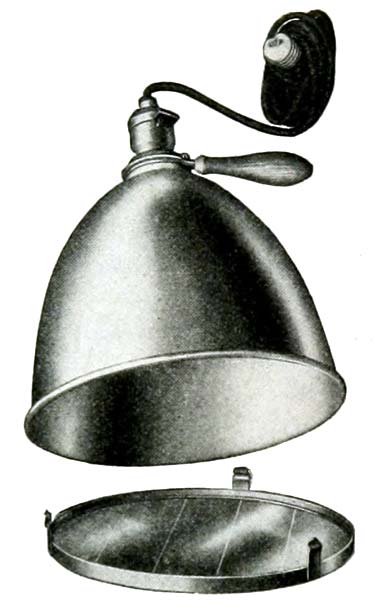
1917 Bell light with cloured glass screen. These lights were used in surgeries, barber shops and beauty salons to generate red and blue light (Matijaca, 1917).
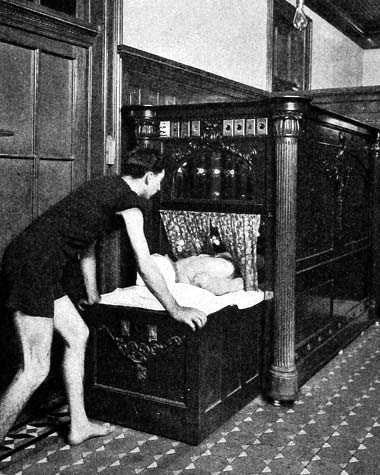
1919 An Electric Light Bath treatment as introduced by Kellogg.
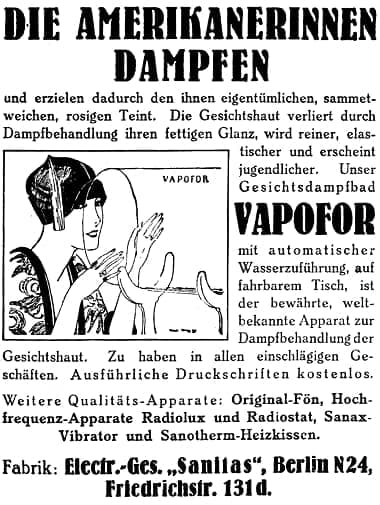
1925 Vapofor (Germany).
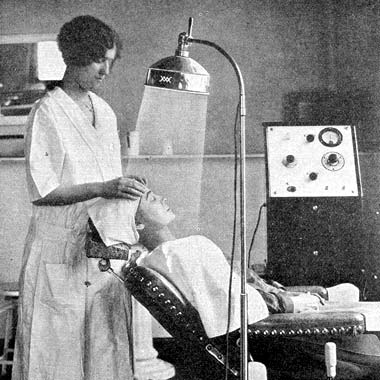
1927 Permalight used in a facial routine. Red or blue glass screens could be attached to the light source when needed (Blood, 1927).
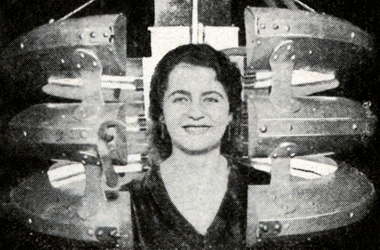
1929 Frigidine New Beauty Treatment for Women. “This light was devised as a substitute for astringent massages. ‘Frigidine’ dries the tissue in the skin, removing it. This causes fresh skin growth to be stimulated and a beautiful complexion is the result.”

1930 Gloria Light Company (Chicago, Illinois) Vapofor. “It has a soft soothing effect, as the skin is made clearer and more beautiful than before. Perfectly safe in every respect.” Made from the early 1920s, the device combined steaming with coloured lights and was used for treatments on the face or hair. At least one of the bulbs pictured in the device was blue. Both may have been blue but it is possible that the other was red.
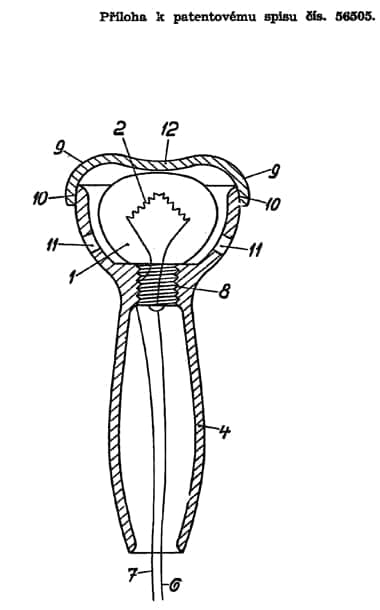
Image from the 1936 Floros Czech patent (No. 56505).
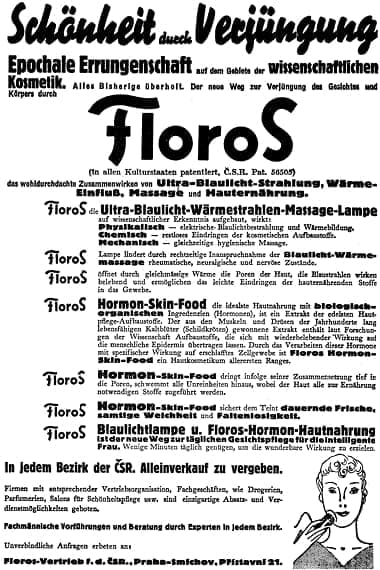
1936 Floros Ultra-Blaulicht-Wärmestrahien-Massage-Lampe to be used with a hormone cream.
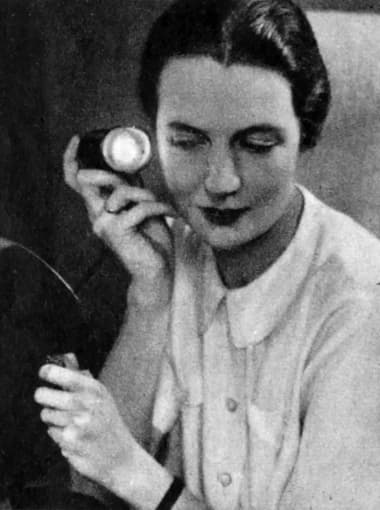
1935 Helene Pessl Floros lamp (Vienna).
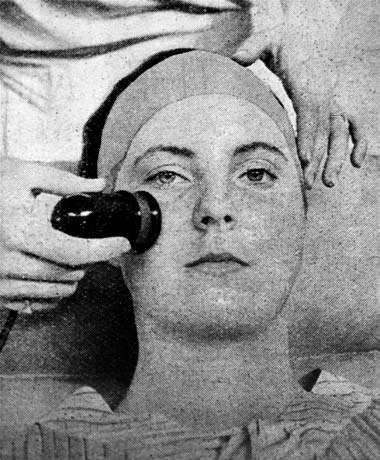
1935 Gallia Dermina lamp, a Floros-like device.

1939 Floros Blue Lamp. The blue light was combined with a radioactive cream.
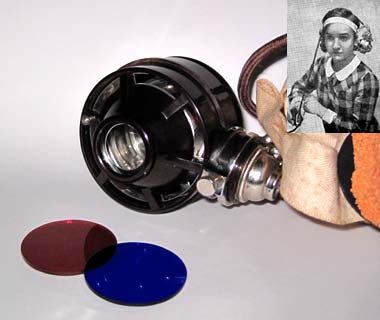
1935 German device for ear problems that relied on the supposed benefits of red and blue light. It consists of a simple white light globe with red and blue glass screens. Presumably the red light was to warm and heal, the blue to soothe and disinfect.
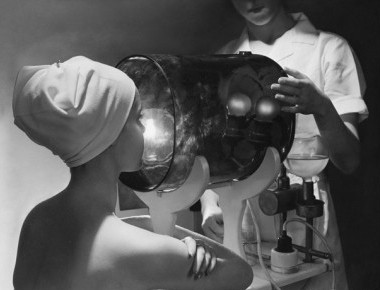
1936 A Vapofor used in an Helena Rubinstein salon.
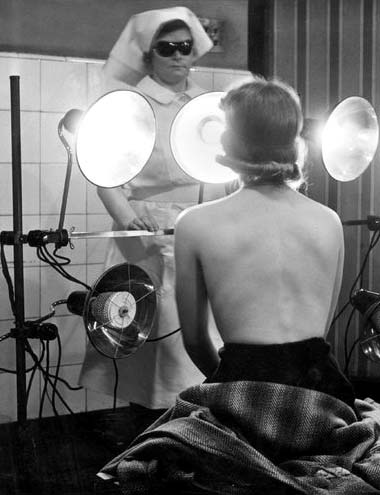
1942 Mixray medical treatment being supervised by a nurse. These treatments use a mix of true infra-red (bottom) and ultaviolet (top) lamps. The ultraviolet light used is not true and is emiting some visible light as well. Although it does not look it, the bottom light is on – true infra-red lamps do not give off any visible radiation. Note the use of goggles to protect against the UV light.

A post-war Perihel Mixray Sunlamp. Many of the claims once made for red and blue light have now moved to the invisible parts of the spectrum.
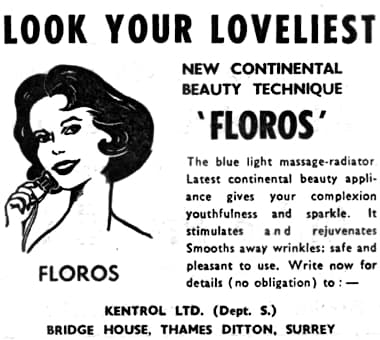
1959 Kentrol Floros blue light massage-radiator. Floros revived by another company without the radioactive cream.
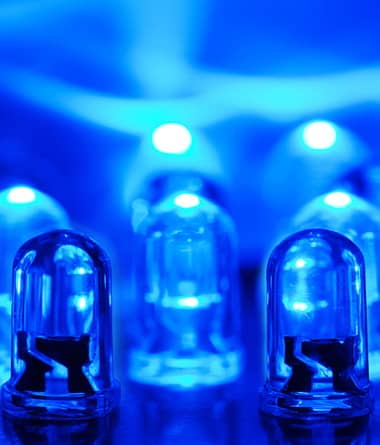
Blue LEDs (Light-Emitting Diodes).
